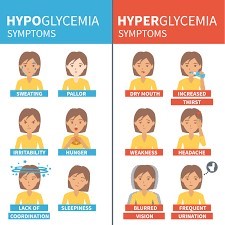A nurse is providing teaching to a client who has a new diagnosis of type 1 diabetes mellitus. The nurse should instruct the client to monitor for which of the following findings as a manifestation of hypoglycemia?
Irritability
Increased urination
Vomiting
Facial flushing
The Correct Answer is A
Irritability.

The rationale for each choice is as follows:
- A. Irritability: Correct. Irritability is one of the signs of hypoglycemia, which occurs when blood glucose levels fall below 70 mg/dL (3.9 mmol/L). Other signs include shakiness, sweating, hunger, headache, confusion, and blurred vision.
- B. Increased urination: Incorrect. Increased urination is one of the signs of hyperglycemia, which occurs when blood glucose levels rise above 180 mg/dL (10 mmol/L). Other signs include thirst, dry mouth, fatigue, nausea, and fruity breath odor.
- C. Vomiting: Incorrect. Vomiting is not a specific sign of hypoglycemia or hyperglycemia, but it can occur as a complication of either condition if left untreated or poorly managed.
- D.Facial flushing: Incorrect. Facial flushing is not a sign of hypoglycemia or hyperglycemia, but it can occur as a side effect of some medications used to treat diabetes, such as niacin or rosiglitazone.
Nursing Test Bank
Naxlex Comprehensive Predictor Exams
Related Questions
Correct Answer is A
Explanation
Choice A rationale:
Irritability is a common withdrawal symptom in newborns exposed to cocaine during pregnancy. Cocaine exposure can lead to irritability, restlessness, and difficulty in consoling the newborn.
Choice B rationale:
Hypotonicity, or decreased muscle tone, is not a common finding associated with cocaine exposure in newborns. Cocaine exposure more commonly results in hypertonicity, where the muscles are tense and rigid.
Choice C rationale:
Decreased auditory startle response is not a typical finding associated with cocaine exposure. Newborns exposed to cocaine may have an exaggerated startle response, which is the opposite of the expected finding in this case.
Choice D rationale:
Increased head circumference is not a characteristic finding associated with cocaine exposure. Cocaine exposure is more likely to cause growth restriction, low birth weight, and microcephaly (small head size) in newborns.
Correct Answer is D
Explanation
Choice A rationale:
Human papillomavirus (HPV) vaccination is recommended for adolescents and young adults to prevent HPV-related cancers and diseases. However, in the context of older adults, especially those who are not previously vaccinated, the priority shifts to other immunizations that are more relevant to their age group.
Choice B rationale:
Rotavirus vaccination is administered to infants to protect against rotavirus infections, which can cause severe diarrhea and dehydration. It is not a priority immunization for older adults. Older adults are at higher risk for certain diseases, and their immunization focus should be on vaccines that prevent those specific conditions.
Choice C rationale:
Diphtheria, tetanus, and acellular pertussis (DTaP) vaccination is essential for children and adults, especially for those who have not received a complete series of vaccinations. However, the question specifies older adults, and DTaP is typically administered to children. While it is crucial for healthcare providers and family members to stay up-to-date with their vaccinations, other immunizations are more pertinent for older adults.
Choice D rationale:
Herpes zoster vaccination (shingles vaccine) is recommended for adults aged 50 years and older. Herpes zoster is a painful rash caused by the reactivation of the varicella-zoster virus, which also causes chickenpox. Older adults are at higher risk of developing shingles, and vaccination can reduce the likelihood of the disease and its complications. Therefore, the nurse should recommend the herpes zoster vaccine to the group of older adults as it aligns with their age and addresses a specific health risk they face.
Whether you are a student looking to ace your exams or a practicing nurse seeking to enhance your expertise , our nursing education contents will empower you with the confidence and competence to make a difference in the lives of patients and become a respected leader in the healthcare field.
Visit Naxlex, invest in your future and unlock endless possibilities with our unparalleled nursing education contents today
Report Wrong Answer on the Current Question
Do you disagree with the answer? If yes, what is your expected answer? Explain.
Kindly be descriptive with the issue you are facing.
